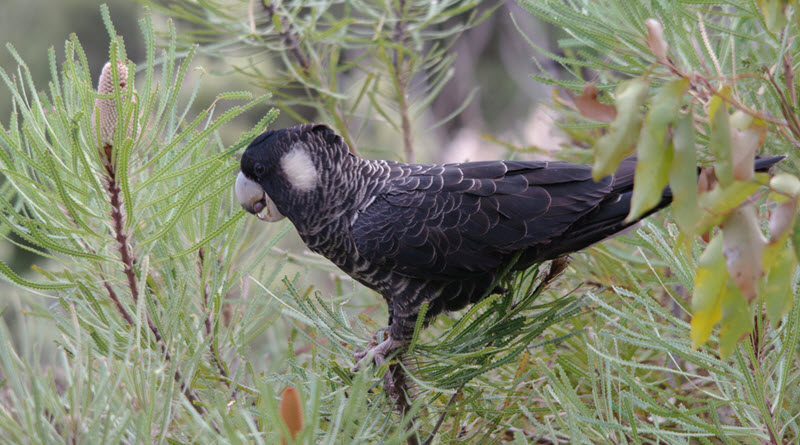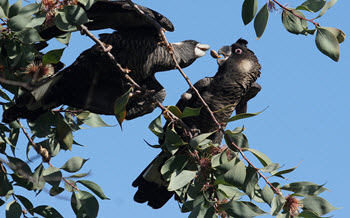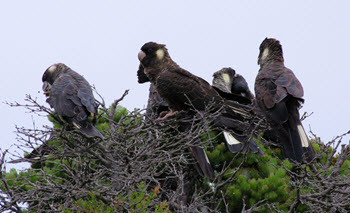Read more about:

Picture by Ralph Green
The Carnaby’s Black Cockatoo is also known by the scientific name Calyptorhynchus latirostris. They were first described in 1948 by Ivan Carnaby – thus the name.
It is also referred to as the short-billed black cockatoo. They are found only in Western Australia.
They are one of only two species of black cockatoos with white tails. The other is the Baudin’s cockatoo. Both are highly endangered.
The Carnaby’s Black cockatoo is a well-loved icon of Australia.
 Breeding
Breeding

Picture by Ron & Beth
The Carnaby’s black cockatoos begin breeding when they are four years old. They usually build nests and mate between July and February. Nests are built in the hollows of trees in the wandoo woodlands and salmon gum area known as the Wheatbelt. They usually choose Eucalyptus trees and they return to the same tree the next year.
Two eggs are usually laid and one hatches eight days after the first. The second chick rarely survives. The female stays close to the nest while the chick is young. When the female leaves the nest for short periods the male feeds the chick.
The chick stays with the parents for eighteen months.
They mate for life.
Appearance
These birds are known for their short beak thus the name – short-billed cockatoo.
They are black with white spots on their cheeks and a white band on their tails. Females have gray rings around eyes and light colored beaks. Males have black bills and the ring around their eyes is red. Legs are gray on both male and female but females are usually a little lighter.
They have a short crest.
They are a large and impressive bird. Adults grow to around 23 inches in length.
Behavior
These birds, both male and female, have a loud wailing call so they are often heard before they are seen. They make a harsher, screeching call when they are alarmed or sense danger.
They also utter loud calls when fighting with others of their species, or if other birds enter their breeding area.
Males also make short calls to females before mating.
They seem playful and always hungry and looking for food. They are social and often travel and feed in flocks.
Diet
The diet of the Carnaby’s black cockatoo consists mostly of seeds and plants. They forage in trees and break open pods to get the seeds inside. The mainly eat from Eucalyptus, Banksias, Dryandras and Hakeas trees.
They will occasionally forage for seeds on the ground when necessary.
Life Span
They can live for approximately fifty years in the wild.
Threats
The Carnaby’s black Cockatoo is on the endangered species list mainly due to a loss of habitat. It’s estimated that their numbers have shrunk 50% in the last 45 years.

Picture by Ken and Nyetta
Extensive clearing of woodlands and fires has resulted in not enough trees for nesting. Older, hollow trees that are suitable for their nests are often cleared away.
They also face competition from other birds, such as the western long-bill and galahs that also need trees for nesting.
Clearing land also results in less food sources for the Carnaby as well as other cockatoos.
Many of the remaining birds are now past breeding age. This puts the future of the Carnaby’s black cockatoo in extreme danger.
Local groups and organizations have been formed to help replant trees and give endangered birds a place for feeding and nesting. These groups include “Men of the Trees” who received a grant to help re-establish habitat for the cockatoo in the Northern Wheatbelt region.
Illegal poaching is still a problem for many cockatoos.
The main predator of the Carnaby’s black cockatoo is the wedge-tailed eagle.
As Pets
Because of their endangered status they are not as popular as many other cockatoos for pets.
If you do purchase any type of exotic bird as a pet make sure you are purchasing from a seller who obtained the bird legally and is selling legally. A cockatoo captured in the wild will not adapt to being in captivity and will not make a good pet.
Those who plan to breed this species should have extensive experience with cockatoos.
A Few things to consider before buying a Carnaby’s Black Cockatoo
These birds have a limited diet so you’ll need to pay close attention to what you feed them. The seeds and plants they need to thrive may not be easy or cheap to acquire.
As with other cockatoos, their call can be loud. These birds are often not a good pet for those living close to others in an apartment or condo. Also, always check to be sure your complex allows exotic pets.
In general, these cockatoos are best enjoyed in their natural habitat. Every effort should be made to ensure these birds have the woodland environment needed to allow them to breed and raise their chicks. Otherwise their future existence is in peril.

